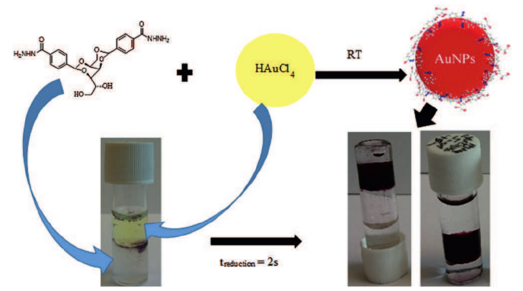Conducting gels—from waste to wealth

Research by scientists at the University of York has demonstrated an innovative way of using a gel to extract precious metals such as silver and gold from waste and convert them into conducting nanoparticles to form a hybrid nanomaterial potentially suitable for a range of high-tech applications.
Discarded electronic devices are an ever-increasing waste stream containing high-value precious metals such as silver and gold. Making use of this resource was the inspiration for the research by a team from the Department of Chemistry at York.
Professor David Smith and Babatunde Okesola, a PhD student supported by The Wild Fund, discovered that their self-assembling gels derived from sorbitol, a simple sugar, could selectively extract precious metals from complex mixtures of other metals typical of the electronics or mining industries.
On exposure to the gel, not only were the precious metals selectively extracted, but they were also then converted into conducting nanoparticles via an in situ chemical reduction process, caused by the nanofibres of the gel network. These conducting nanoparticles become embedded in the gel giving it enhanced electrical conductance.
Fellow Department of Chemistry researchers, Dr Alison Parkin and Sindhu Suravaram, helped demonstrate the reduction mechanism which converts the metal ions into nanoparticles and explored the conducting nature of the resulting soft materials. The research is published in Angewandte Chemie.
Babatunde Okesola said: "Importantly, gels have properties of both solids and liquids so these conducting gels are potentially ideal to bridge between the soft, wet world of biology and the hard, dry world of electronics. Being able to 'wire up' this interface will be of increasing importance in future technologies."
Dr Smith added: "We hope to go on and test our gels using real-world electronic waste, and also explore the potential applications of the resulting materials at the interface between biology and electronics." This will allow Professor Smith, Dr Parkin and their research teams to use the gels to convert waste into new soft materials capable of high-tech applications in their own right.
More information: Babatunde O. Okesola et al. Selective Extraction and In-Situ Reduction of Precious Metal Salts from Model Waste to Generate Hybrid Gels with Embedded Electrocatalytic Nanoparticles, Angewandte Chemie International Edition (2015). DOI: 10.1002/anie.201507684
Journal information: Angewandte Chemie , Angewandte Chemie International Edition
Provided by University of York


















